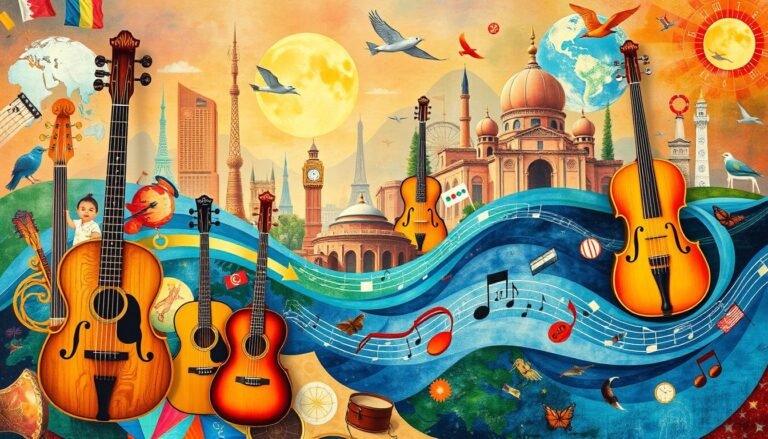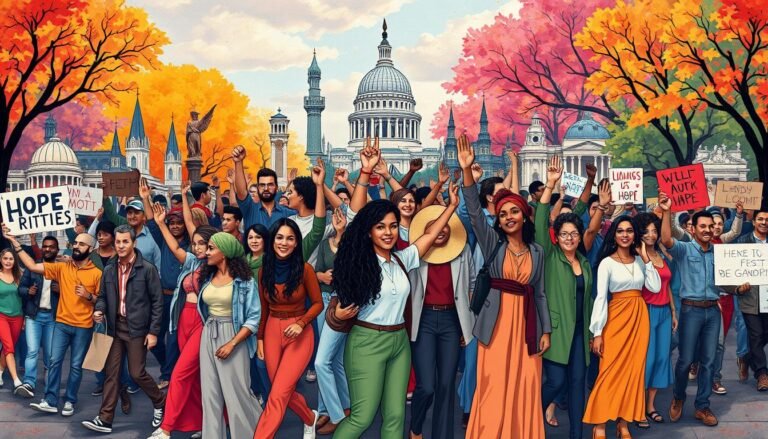Exploring the Sociology of Religion: Secularization and Pluralism
Is the world becoming less religious, or are belief systems changing? This question is central to the sociology of religion. It looks at how faith and society interact. In our fast-changing world, understanding secularization and pluralism is key.
The study of secularism shows how religious groups and practices change with the times. We see a drop in traditional church attendance and a rise in personal spirituality. This field helps us understand how faith is evolving.
At the same time, religious diversity shapes our communities. It challenges old beliefs and creates new ones.
James A. Beckford’s work has been crucial in linking religious sociology with societal trends. His 2003 book, “Social Theory and Religion,” looks at how globalization and new religious movements change our view of faith. These forces help us see how beliefs change with society.
As we dive deeper, we’ll see how people and groups find spiritual meaning in a secular world. We’ll look at how public and private religious expressions are becoming mixed. This affects our communities and institutions.
Key Takeaways
- Sociology of religion examines the interplay between faith and society
- Secularization and pluralism are key concepts in understanding modern religious dynamics
- James A. Beckford’s work links religious sociology to broader societal trends
- Globalization and new religious movements shape our understanding of faith
- The boundaries between public and private religious expressions are shifting
Understanding the Sociology of Religion
The sociology of religion looks at how faith and society are connected. It studies how religious stories shape our social rules and cultural values. This area is interesting because it looks at how beliefs change over time.
Defining the Field of Study
This field studies how religious actions and beliefs work with society. It looks at how faith affects who we are and how we work together. Now, it covers many different religions and their place in today’s world.
Key Concepts and Theories
Important ideas like secularization and cultural pluralism are key. Scholars study how faith changes with modern times and lives with many beliefs. These ideas help us see how religion is changing in our global world.
Historical Development of Religious Sociology
The study of religion in sociology goes way back. Early thinkers like Marx, Durkheim, and Weber started it. Their ideas still shape how we see religion’s role in society. Now, we also look at new religious movements and how technology affects faith.
| Year | Development |
|---|---|
| 1961 | Peter L. Berger publishes “The Noise of Solemn Assemblies” and “The Precarious Vision” |
| 1967 | Berger’s influential work “The Sacred Canopy” is published |
| 2010 | Launch of Annual Review of the Sociology of Religion |
| 2014 | Founding of Review of Religion and Chinese Society |
Today, the study of religion is still growing. It tackles issues like religious diversity in today’s societies and faith’s role in a fast-changing world. This ongoing study helps us understand the complex relationship between religion and modern life.
The Concept of Secularization in Religious Studies
Secularization theory is key in understanding how society and religion change with modernization. It says that as society becomes more modern, religion’s role in society and government lessens. This happens because of the rise of rational thinking, science, and technology.
Defining Secularization
Secularization means that religion’s impact on social life decreases. It’s mainly based on Protestant Christianity. This idea helps us see how religious groups and modern society interact.
Theoretical Streams of Secularization
Jack David Eller found ten different views on secularization. Most of these views don’t mean people will stop believing in God. C. John Sommerville talked about six ways the term is used in science, including one about how society changes.
Critiques of Traditional Secularization Theory
Traditional views on secularization have faced challenges. Peter L. Berger came up with “desecularization” to explain why religious beliefs are growing even as fewer people don’t believe in religion. Studies show that the number of non-religious people might be going down for other reasons. Europe is an exception, with its religious history and trends being mixed.
“Many individuals who do not identify with a religion still adhere to religious beliefs and practices.”
This fact makes us rethink secularization. It shows that understanding secularism in sociology needs a deeper look at how people see and practice religion today.
Religious Pluralism: Definitions and Implications
Religious pluralism means many faiths living together in one place. It’s more than just accepting each other. It celebrates the variety of beliefs in a community.
The move to religious pluralism was a big change. It started in the late 1700s in the United States. Back then, the country moved from just tolerating different beliefs to fully supporting them.
Talking across faiths helps people understand each other better. This kind of dialogue builds respect and cooperation. It can lead to seeing all beliefs as equal or mixing practices from different faiths.
Religious pluralism affects how societies stick together and make laws. It pushes for policies that include everyone, no matter their beliefs. The Gini index shows how diverse religious beliefs are in different places.
“The more diverse the resources, the more diverse the population of religious suppliers in an area.”
Things like age, race, gender, and religion play a big part in how religious pluralism grows. These factors shape the religious mix in a society. Knowing about them helps build peaceful communities with different beliefs.
There’s a lot of discussion about religious pluralism in many fields. Experts in sociology, economics, and religion study its impact on how people live and interact. With the world getting more connected, understanding religious diversity becomes more important.
Exploring the Sociology of Religion: Secularization and Pluralism
The study of religion’s sociology looks at how secularization and pluralism affect belief systems. These ideas change how people practice religion in today’s world. With more religious groups, old ways of doing things are facing new challenges.
Intersections between Secularization and Pluralism
Secularization and pluralism cross paths in complex ways. Some believe that more religious groups lead to less faith by breaking down religious control. Others think it can make faith stronger. The American Sociological Review has looked into this with seven articles, but there’s no clear answer yet.
Impact on Religious Participation
How people attend religion varies around the world. In the U.S., fewer people believe in God now than in the 1940s. Church membership has also dropped. Canada saw a big fall in church attendance from the 1960s to 2015. Australia had 53% of people believing in religion in 2020.
Societal Implications of Religious Diversity
Having many religions affects society in many ways. The Religious Diversity Index (RDI) went up by 61.11% worldwide after World War II. Latin America saw the biggest increase. Countries with lots of religious diversity are often in North America, the Caribbean, and Sub-Saharan Africa. Studies show that these countries tend to grow economically better.
“The more diverse the resources, the more diverse the population of suppliers that feed off those resources will be.”
This quote from Stark and Finke shows how religious diversity can create a lively spiritual market. As beliefs change, societies must adapt to the new mix of faith and secular life.
Globalization and Its Effects on Religion
Globalization has changed how people practice their faith around the world. It has led to big changes in religious beliefs and practices. This mix of faith and modern life has made religions adapt and evolve.
Religious Responses to Globalization
Religious groups have found different ways to deal with globalization. Some connect with people all over the world, while others hold on to their local traditions. This has led to a mix of faiths living together and sharing their beliefs globally.
Transnational Religious Movements
Religious ideas are now spreading across borders. Thanks to modern tech, these ideas can reach people everywhere. This has changed how religious stories are told and shared.
Challenges to Traditional Religious Structures
In today’s global world, old religious ways are facing big challenges. More people are choosing their own spiritual paths, and there’s more variety in faiths. This means traditional religious groups must change or they might not survive.
| Impact of Globalization | Percentage |
|---|---|
| People influenced in religious views | 68% |
| Rise in religious pluralism | 42% |
| Increase in interreligious dialogue | 55% |
As we move forward, religious groups must deal with the blend of old and new. The future of faith in our connected world will be both tough and exciting.
The Role of Religion in Modern Society
Religion is still a big deal in today’s world. It shapes our beliefs and who we are. Even though some thought it would fade away, faith is still a big part of social and political issues worldwide. The mix of old beliefs and new challenges makes things interesting.
Now, we see many different religions living together in one place. This mix makes communities richer but can also cause conflicts. Churches and other religious groups are finding new ways to stay connected with people and stay important in our fast-changing world.
In the U.S., people are still pretty religious, even though some think they wouldn’t be. A study in 2013 showed that some people saying they have no religion might just mean they’re not into specific churches anymore. Europe is different, though. It’s seen as less religious, thanks to its history.
“Religion continues to play a significant role in shaping individual and collective identities, even as societies become more diverse and technologically advanced.”
There’s a lot of debate about how religion fits into our public lives. People argue about where religious and secular life should meet. Understanding how religion works in our lives is key to building communities that get along.
Measuring Religious Pluralism: Methods and Challenges
Studying religious diversity in societies with many beliefs is tricky. Researchers use different ways to measure how diverse religions are. They also look at how this affects trends in secularization and pluralism.
The Gini Index of Religious Diversity
The Gini index is a key tool for measuring religious diversity. It has been used in seven articles in the American Sociological Review. These studies looked at how being part of a diverse religious scene affects people’s religious actions.
Alternative Approaches to Measuring Pluralism
There are other ways to measure how diverse religions are in a place:
- Counting how many religious groups there are
- Looking at how many people follow each group
- Looking at the quality of diversity
Interpreting Pluralism Data
When looking at data on religious diversity, we must think about the context. A study from 1980 to 2010 found that areas with more religious groups had fewer people going to church later on.
| Year | Religious Diversity | Participation Rate Change |
|---|---|---|
| 1980 | Low | Stable |
| 1990 | Moderate | Slight Decline |
| 2000 | High | Moderate Decline |
| 2010 | Very High | Significant Decline |
This data shows a complex link between religious diversity and people leaving religion. It shows we need to look closely at how different religions affect society.
Future Trends in Religious Sociology
The study of religious sociology is changing fast, showing how faith and modern life are blending. We see new trends that are shaping how we study and practice religion.
Emerging Research Areas
Sociologists are looking beyond traditional religious groups. They’re studying how faith connects with the environment, AI, and changing family structures. This shows that religious stories are part of everyday life, not just in churches.
Technological Impacts on Religious Practice
Technology is changing how we practice religion. Now, we have online services, virtual pilgrimages, and apps for faith. These tools are creating new kinds of religious communities that cross borders and change how we connect spiritually.
Predictions for Religious Diversity
We expect to see more religious diversity around the world. In the U.S., more people are saying they have no religion, going from 16% in 2007 to 33% in 2021. This means more people are exploring different spiritual paths or not following any.
At the same time, we might see a divide between those who are religious and those who are not. This will make the religious scene more complex.
As religious sociology advances, it will likely use more different fields to understand how faith and society interact. This will help us grasp the complex ways faith is changing in our fast-paced world.
Conclusion
The study of secularism and religious diversity is always changing. It looks at how faith, society, and culture interact. For example, Hadaway’s study found that many Americans say they go to church but don’t really. This shows how complex religious practices can be.
Even though some thought religion would fade away, it’s actually growing worldwide. This is because more people are being born in developing countries, where faith is key. Stark and Bainbridge believe that people stay religious because it meets deep human needs.
Religion still matters a lot in today’s world. That’s why studying it is so important. We need to look at how global trends and local beliefs mix. We also need to think about how technology affects faith. Understanding secularization and pluralism helps us grasp the changing nature of religion.
Source Links
- Pluralism and Secularism
- Insights by James A. Beckford
- Föredrag, Bochum 9
- Content Pages of the Encyclopedia of Religion and Social Science
- The New Sociology of Religion
- Secularization
- Secularization Theory and Religion | Politics and Religion | Cambridge Core
- Religious pluralism
- Pluralism as Outcome: The Ecology of Religious Resources, Suppliers, and Consumers
- Why Nations Are Becoming More Secular
- Exploring the trend in religious diversity: Based on the geographical perspective
- Religion and Globalization: New Possibilities, Furthering Challenges
- Religion and Globalization: José Casanova
- Religion and Modern Society
- A Conversation with Peter L. Berger:
- In-Between Spaces. Pluralism and Hybridity as Elements of a New Paradigm for Religion in the Modern Age – Human Studies
- 13.10 Current and Future Trends in Religious Belief and Activity – Exploring Our Social World: The Story of Us
- Toward a new sociology of religion
- Secularisation – Is Society Becoming More Secular?
- Secularization Theory’s Differentiation Problem: Revisiting the Historical Relationship between Differentiation and Religion
- Religious Exiting and Social Networks: Computer Simulations of Religious/Secular Pluralism | Secularism and Nonreligion







